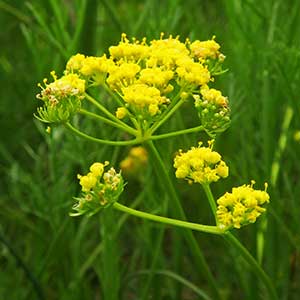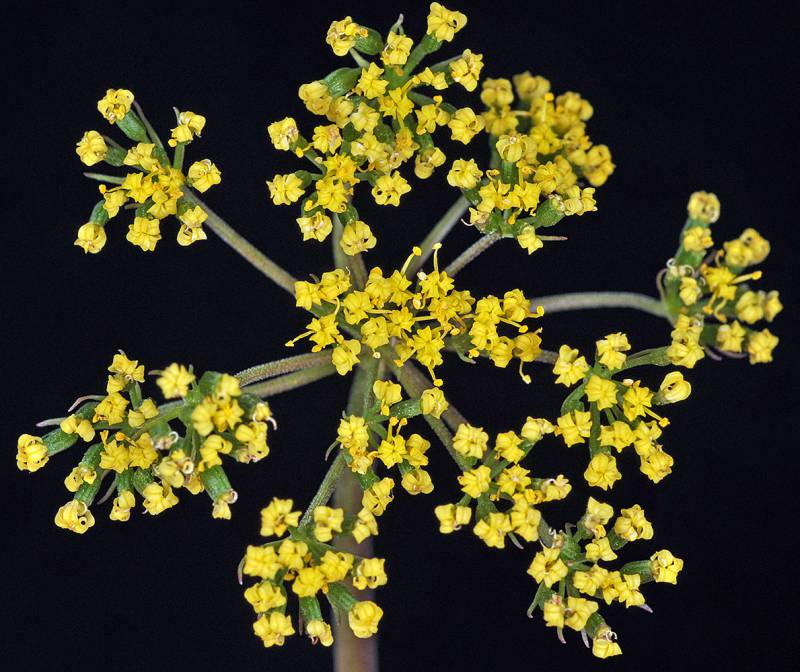|
Bradshaw's biscuit-root, Bradshaw's desert-parsley, Bradshaw's lomatium
|
Rollins's biscuit-root, Rollins's desert-parsley
|
| Glabrous, acaulescent perennial from a long, slender taproot, 2-6.5 dm. tall. |
Sparingly-branched perennial from a short taproot, 2-7 dm. tall. |
Leaves ternate-pinnately dissected into linear or filiform segments 3-10 mm. long and up to 1 mm. wide. |
Leaves cauline and basal, irregularly pinnately dissected into unequal narrow segments up to 1 cm. long. Taproot short, tuberous-thickened or with 2 or more globose-thickened portions. |
Inflorescence a compound umbel, the rays unequal, 4-13 mm. long; with usually only 2-5 fertile flowers; involucre wanting; bractlets of the involucel ternately or bi-ternately divided; calyx teeth obsolete, flowers yellow. |
Inflorescence of compound umbels, the rays 3-7 cm. long at maturity; involucre none; involucel of inconspicuous, narrow bractlets; calyx teeth obsolete, flowers yellow; pedicels 4-10 mm. long. |
Fruit glabrous, 8-13 mm. long and 5-7 mm. wide, the corky-thickened lateral wings half as wide as and the same color as the body. |
Fruit glabrous, elliptic, 5-8 mm. long, the lateral wings well-developed, but barely as wide as the body. |
|
|
|
|
| May-June |
April-May |
| Wet meadows at low elevations. |
Open slopes in grasslands, on rocky or fine-textured, loess-derived soils, from valleys to the montane. |
Occurring west of the Cascades crest in Clark County in Washington; southwestern Washington to the Willamette Valley near Eugene, Oregon.
|
Occurring east of the Cascades crest in the southeastern counties in Washington; southeastern Washington to the canyons of the Snake and lower Salmon Rivers in eastern Oregon and western Idaho.
|
| Native |
Native |
| Endangered in Washington (WANHP) |
Threatened in Washington (WANHP) |
L. ambiguum, L. anomalum, L. brandegeei, L. brevifolium, L. canbyi, L. columbianum, L. cous, L. cuspidatum, L. dissectum, L. farinosum, L. geyeri, L. gormanii, L. klickitatense, L. knokei, L. laevigatum, L. leptocarpum, L. linearifolium, L. lithosolamans, L. macrocarpum, L. martindalei, L. multifidum, L. nudicaule, L. papilioniferum, L. piperi, L. quintuplex, L. rollinsii, L. roneorum, L. salmoniflorum, L. sandbergii, L. serpentinum, L. simplex, L. suksdorfii, L. tamanitchii, L. tenuissimum, L. thompsonii, L. triternatum, L. tuberosum, L. utriculatum, L. watsonii |
L. ambiguum, L. anomalum, L. bradshawii, L. brandegeei, L. brevifolium, L. canbyi, L. columbianum, L. cous, L. cuspidatum, L. dissectum, L. farinosum, L. geyeri, L. gormanii, L. klickitatense, L. knokei, L. laevigatum, L. leptocarpum, L. linearifolium, L. lithosolamans, L. macrocarpum, L. martindalei, L. multifidum, L. nudicaule, L. papilioniferum, L. piperi, L. quintuplex, L. roneorum, L. salmoniflorum, L. sandbergii, L. serpentinum, L. simplex, L. suksdorfii, L. tamanitchii, L. tenuissimum, L. thompsonii, L. triternatum, L. tuberosum, L. utriculatum, L. watsonii |
| |



